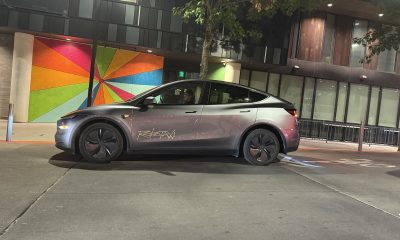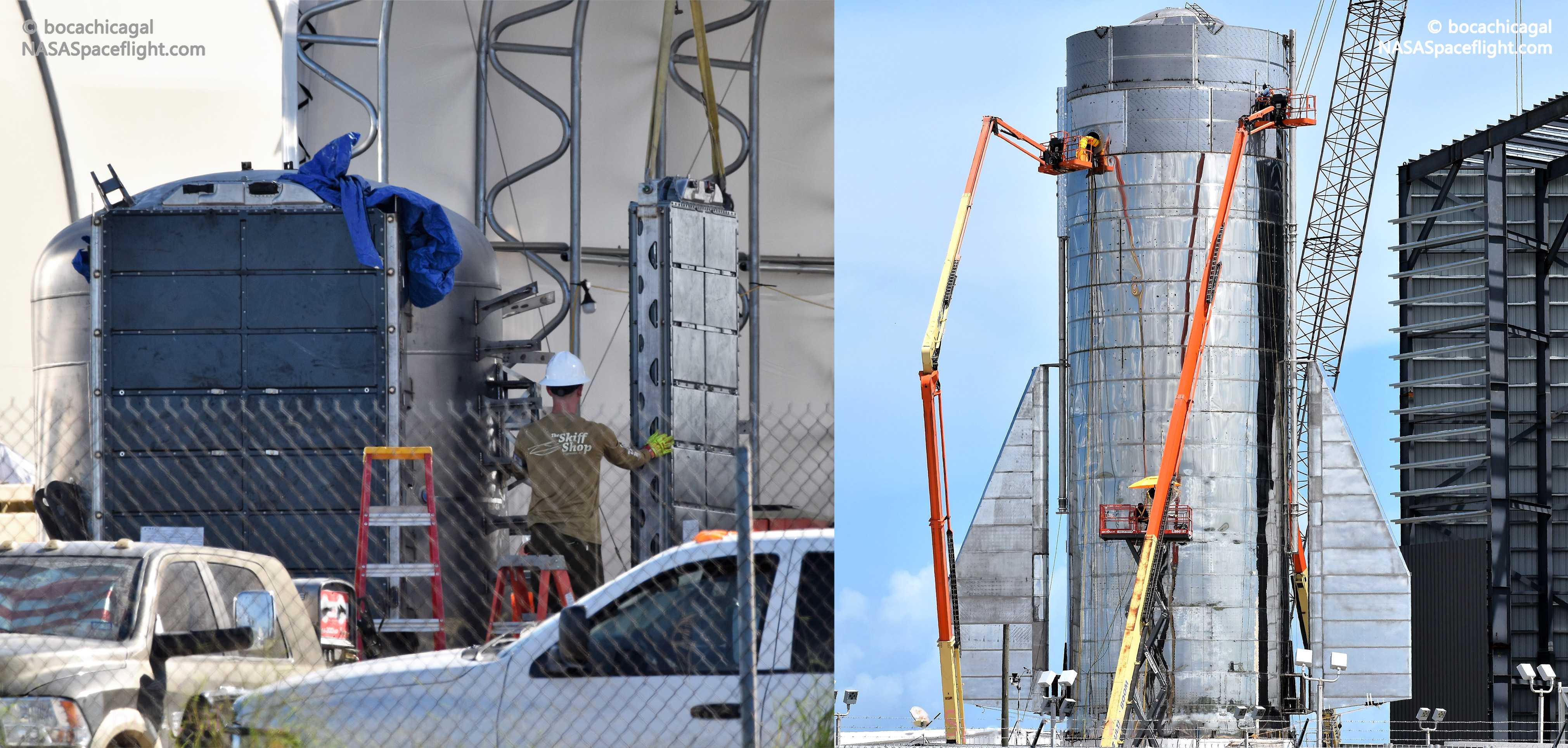

News
SpaceX is installing Tesla battery packs on its Starship MK1 rocket prototype
First noticed by NASASpaceflight.com forum member “exilon”, SpaceX appears to have selected off-the-shelf Tesla battery packs as the power storage method of choice for its Starship Mk1 prototype, currently in the midst of a busy period of integration
Potentially taken directly from Tesla Model S/X powertrains otherwise headed for recycling, SpaceX technicians have spent the last 24 or so hours attaching numerous battery packs to part of a Starship subsystem known as header tanks. This is the latest addition to SpaceX and Tesla’s relatively close relationship – the two have begun to work together to solve challenges with materials science, batteries, and more within the last 12-24 months.
While initially surprising, the appearance of battery packs quite literally taken from Tesla Model S/X vehicles or their Gigafactory assembly line actually makes a lot of sense. By using prepackaged, off-the-shelf battery systems with industry-leading power management capabilities, SpaceX is probably saving a huge amount of time, money, and effort. If the battery packs were already nearing the end of their useful automotive lives, the net cost could very well approach zero, aside from what looks like a minimal mounting brace. It’s possible that SpaceX has even pursued modifying and certifying large Tesla-derived battery packs for use on orbital Starship missions.
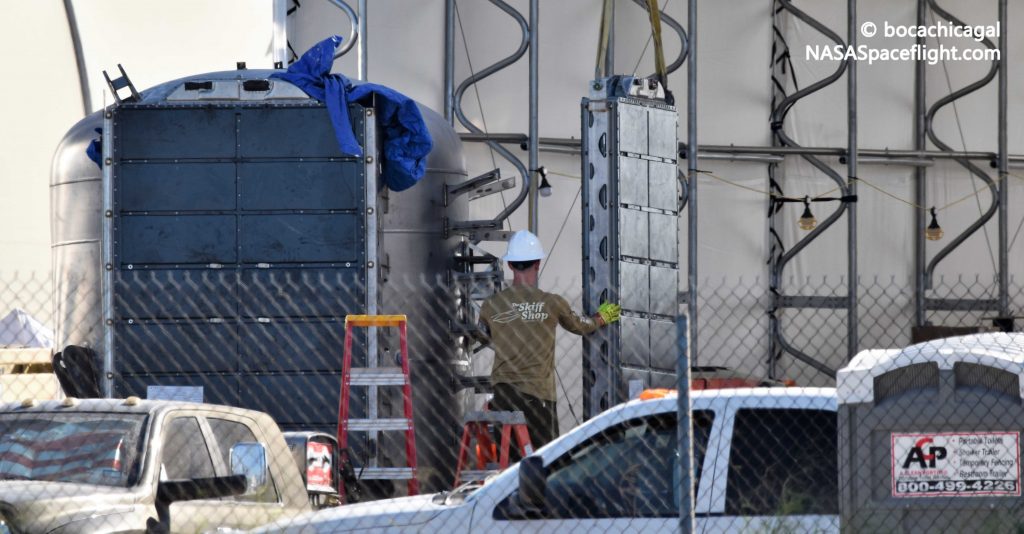
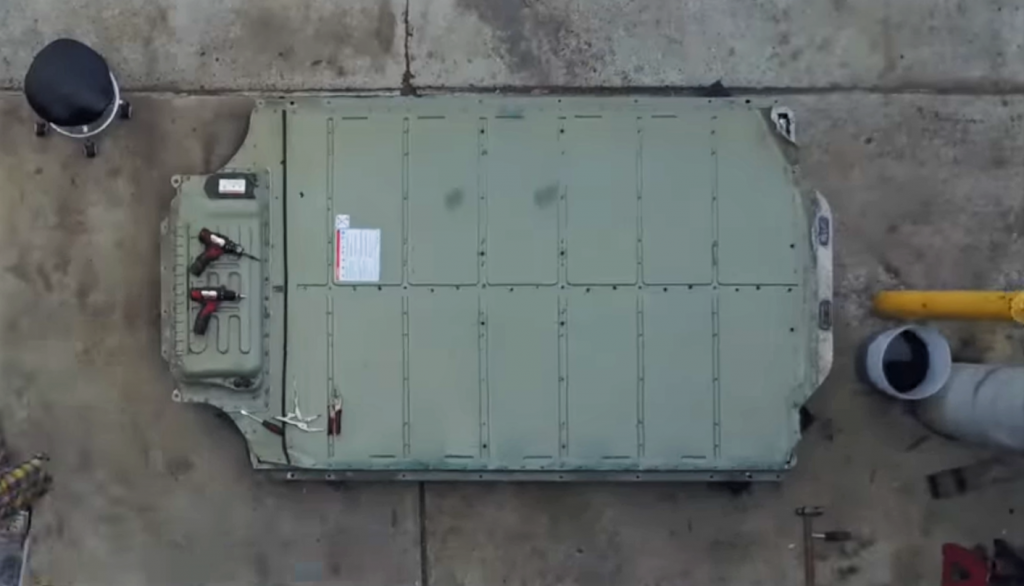
These battery packs were spotted by an eagle-eyed forum user who was first to recognize the hardware for what it likely was. Per the above photo, SpaceX appears to have joined two self-contained Tesla battery packs into single units that were then installed on a header tank. Knowing that the highest capacity Tesla offers is ~100 kWh, the 2×2 packs could store up to 400 kWh and offer instantaneous power output (ignoring thermal limitations) well into the megawatt (MW) range. It’s unclear if the first header tank also had batteries attached but SpaceX technicians began installing that tank inside Starship’s nose cone on the evening September 22nd. Tank #2 will likely follow in the next 24 hours per Musk’s indication that Starship Mk1 would be stacked to its full height on Wednesday.
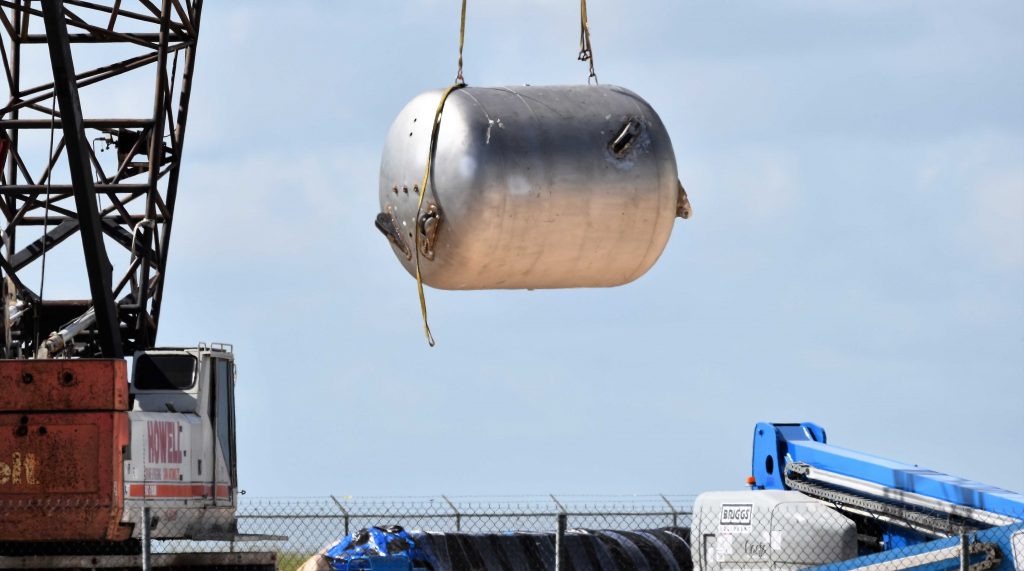
For unknown reasons, SpaceX is choosing to mount the ~1000 kg (2200 lb) battery pack pairs directly onto the outside of one of Starship Mk1’s two header tanks. These tanks compliment the rocket prototype’s main propellant tanks and are meant to serve as small reserves of fuel (methane) and oxidizer (oxygen) that can be pressurized independently. During dramatic in-space and in-atmosphere maneuvers, the g-forces exerted on Starship could easily find the vehicle’s propellant pushed away from the ‘bottom’ of its main tanks, creating bubbles or voids that can damage and destroy rocket engines if ingested.
Pressurizing the entirety of the main tanks (a cylinder measuring 9m by ~40m or 30×130 ft) is extremely impractical – hence the need for much smaller header tanks. Falcon 9 boosters are able to sidestep this issue because they are small and light enough (relatively speaking) that cold gas thrusters can efficiently generate the positive Gs needed to safely ignite its engines for recovery and landing maneuvers. Empty, Starship alone will likely weigh no less than 4-6 times as much as a Falcon 9 booster (~25 tons, 55,000 lb).
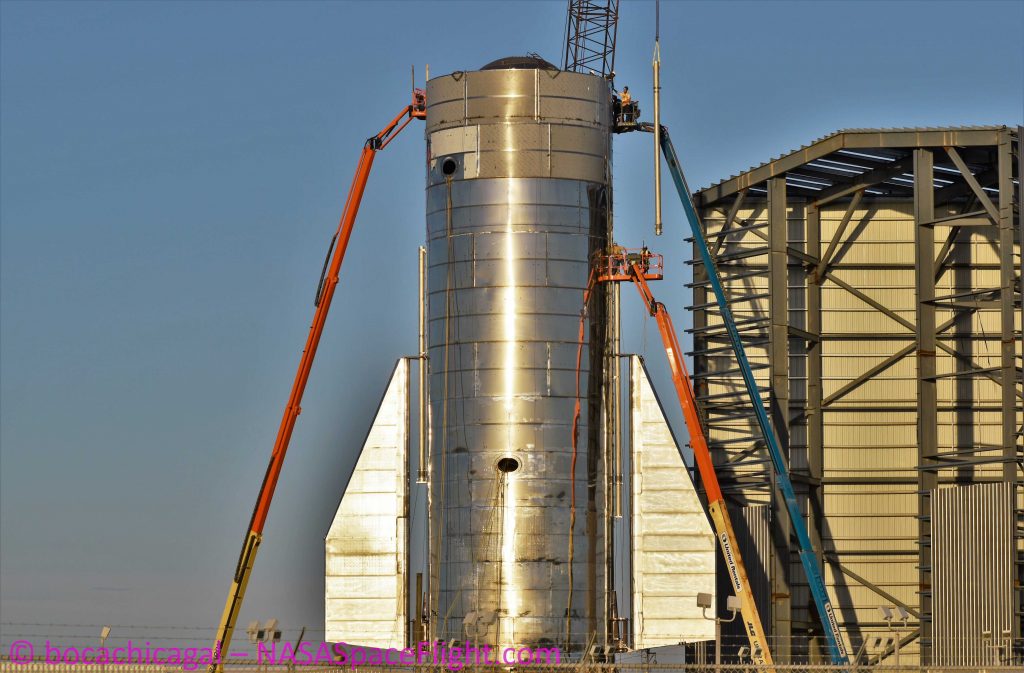
According to CEO Elon Musk, SpaceX has decided to install those header tanks in the very tip of Starship Mk1’s conical nose to help balance out the vehicle’s center of mass. As a side-effect, SpaceX will have to install feed lines that run the entire length of the spacecraft and protect them with steel aero-covers. It’s unclear if this design choice is necessitated by Starship’s early, prototypical form or if – once outfitted with crew quarters or a functional cargo bay – it’s possible that that added mass will serve as enough of a counterbalance to preclude the need for ballast in the nose.
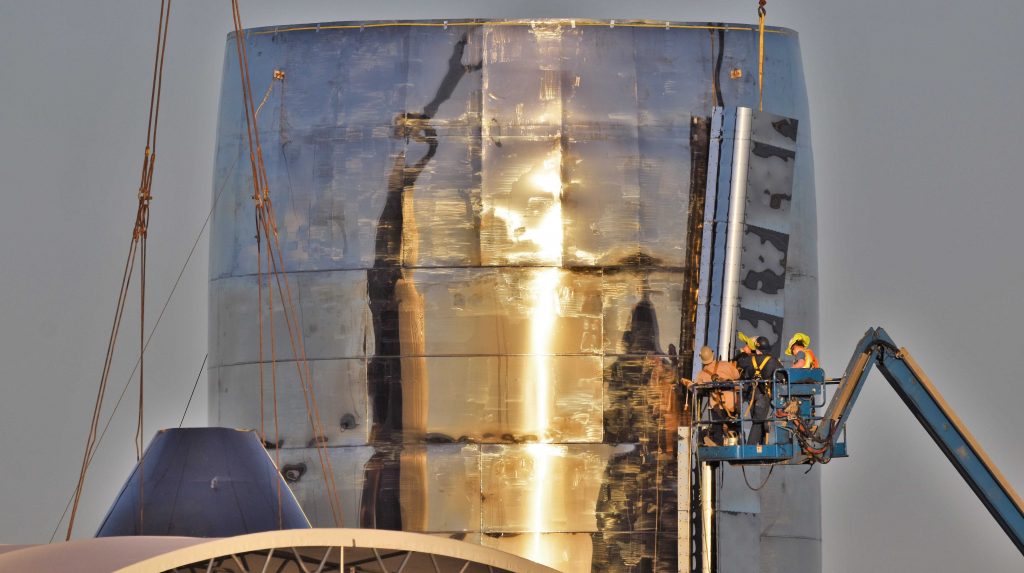
Musk posted a view inside an adjacent SpaceX fabrication facility in Boca Chica on September 23rd, showing a large row of staged steel sheets that will eventually be formed into aerodynamic shrouds for Starship Mk1’s raceways, fins, and wings.
Check out Teslarati’s Marketplace! We offer Tesla accessories, including for the Tesla Cybertruck and Tesla Model 3.
Elon Musk
Tesla investors will be shocked by Jim Cramer’s latest assessment
Jim Cramer is now speaking positively about Tesla, especially in terms of its Robotaxi performance and its perception as a company.

Tesla investors will be shocked by analyst Jim Cramer’s latest assessment of the company.
When it comes to Tesla analysts, many of them are consistent. The bulls usually stay the bulls, and the bears usually stay the bears. The notable analysts on each side are Dan Ives and Adam Jonas for the bulls, and Gordon Johnson for the bears.
Jim Cramer is one analyst who does not necessarily fit this mold. Cramer, who hosts CNBC’s Mad Money, has switched his opinion on Tesla stock (NASDAQ: TSLA) many times.
He has been bullish, like he was when he said the stock was a “sleeping giant” two years ago, and he has been bearish, like he was when he said there was “nothing magnificent” about the company just a few months ago.
Now, he is back to being a bull.
Cramer’s comments were related to two key points: how NVIDIA CEO Jensen Huang describes Tesla after working closely with the Company through their transactions, and how it is not a car company, as well as the recent launch of the Robotaxi fleet.
Jensen Huang’s Tesla Narrative
Cramer says that the narrative on quarterly and annual deliveries is overblown, and those who continue to worry about Tesla’s performance on that metric are misled.
“It’s not a car company,” he said.
He went on to say that people like Huang speak highly of Tesla, and that should be enough to deter any true skepticism:
“I believe what Musk says cause Musk is working with Jensen and Jensen’s telling me what’s happening on the other side is pretty amazing.”
Tesla self-driving development gets huge compliment from NVIDIA CEO
Robotaxi Launch
Many media outlets are being extremely negative regarding the early rollout of Tesla’s Robotaxi platform in Austin, Texas.
There have been a handful of small issues, but nothing significant. Cramer says that humans make mistakes in vehicles too, yet, when Tesla’s test phase of the Robotaxi does it, it’s front page news and needs to be magnified.
He said:
“Look, I mean, drivers make mistakes all the time. Why should we hold Tesla to a standard where there can be no mistakes?”
It’s refreshing to hear Cramer speak logically about the Robotaxi fleet, as Tesla has taken every measure to ensure there are no mishaps. There are safety monitors in the passenger seat, and the area of travel is limited, confined to a small number of people.
Tesla is still improving and hopes to remove teleoperators and safety monitors slowly, as CEO Elon Musk said more freedom could be granted within one or two months.
News
Tesla launches ultra-fast V4 Superchargers in China for the first time
Tesla has V4 Superchargers rolling out in China for the first time.

Tesla already has nearly 12,000 Supercharger piles across mainland China. However, the company just initiated the rollout of the ultra-fast V4 Superchargers in China for the first time, bringing its quick-charging piles to the country for the first time since their launch last year.
The first batch of V4 Superchargers is now officially up and running in China, the company announced in a post on Chinese social media outlet Weibo today.
The company said in the post:
“The first batch of Tesla V4 Superchargers are online. Covering more service areas, high-speed charging is more convenient, and six-layer powerful protection such as rain and waterproof makes charging very safe. Simultaneously open to non-Tesla vehicles, and other brands of vehicles can also be charged. There are more than 70,000 Tesla Superchargers worldwide. The charging network layout covers 100% of the provincial capitals and municipalities in mainland China. More V4 Superchargers will be put into use across the country. Optimize the charging experience and improve energy replenishment efficiency. Tesla will accompany you to the mountains, rivers, lakes, and seas with pure electricity!”
The first V4 Superchargers Tesla installed in China are available in four cities across the country: Shanghai, Zhejiang, Gansu, and Chongqing.

Credit: Tesla China
Tesla has over 70,000 Superchargers worldwide. It is the most expansive and robust EV charging network in the world. It’s the main reason why so many companies have chosen to adopt Tesla’s charging connector in North America and Europe.
In China, some EVs can use Tesla Superchargers as well.
The V4 Supercharger is capable of charging vehicles at speeds of up to 325kW for vehicles in North America. This equates to over 1,000 miles per hour of charging.
Elon Musk
Elon Musk hints at when Tesla could reduce Safety Monitors from Robotaxi
Tesla could be reducing Safety Monitors from Robotaxi within ‘a month or two,’ CEO Elon Musk says.

Elon Musk hinted at when Tesla could begin reducing Safety Monitors from its Robotaxis. Safety Monitors are Tesla employees who sit in the front passenger seat during the driverless rides, and are there to ensure safety for occupants during the earliest rides.
Tesla launched its Robotaxi fleet in Austin last Sunday, and after eight days, videos and reviews from those who have ridden in the driverless vehicles have shown that the suite is safe, accurate, and well coordinated. However, there have been a few hiccups, but nothing that has put anyone’s safety in danger.
A vast majority — close to all of the rides — at least according to those who have ridden in the Robotaxi, have been performed without any real need for human intervention. We reported on what was the first intervention last week, as a Safety Monitor had to step in and stop the vehicle in a strange interaction with a UPS truck.
Watch the first true Tesla Robotaxi intervention by safety monitor
The Tesla and UPS delivery truck were going for the same street parking space, and the Tesla began to turn into it. The UPS driver parallel parked into the spot, which was much smaller than his truck. It seemed to be more of an instance of human error instead of the Robotaxi making the wrong move. This is something that the driverless cars will have to deal with because humans are aggressive and sometimes make moves they should not.
The Safety Monitors have not been too active in the vehicles. After all, we’ve only seen that single instance of an intervention. There was also an issue with the sun, when the Tesla braked abnormally due to the glare, but this was an instance where the car handled the scenario and proceeded normally.
With the Robotaxi fleet operating impressively, some are wondering when Tesla will begin scaling back both the Safety Monitors and Teleoperators that it is using to ensure safety with these early rides.
CEO Elon Musk answered the inquiry by stating, “As soon as we feel it is safe to do so. Probably within a month or two.”
As soon as we feel it is safe to do so.
Probably within a month or two. We continue to improve the Tesla AI with each mile driven.
— Elon Musk (@elonmusk) June 30, 2025
Musk’s response seems to confirm that there will be fewer Teleoperators and Safety Monitors in the coming months, but there will still be some within the fleet to ensure safety. Eventually, that number will get to zero.
Reaching a point where Tesla’s Robotaxi is driverless will be another significant milestone for the company and its path to fully autonomous ride-sharing.
Eventually, Tesla will roll out these capabilities to consumer-owned vehicles, offering them a path to generate revenue as their car operates autonomously and completes rides.
For now, Tesla is focusing on perfecting the area of Austin where it is currently offering driverless rides for just $4.20 to a small group of people.
-

 News5 days ago
News5 days agoTesla Robotaxi’s biggest challenge seems to be this one thing
-

 News2 weeks ago
News2 weeks agoTesla confirms massive hardware change for autonomy improvement
-

 Elon Musk2 weeks ago
Elon Musk2 weeks agoElon Musk slams Bloomberg’s shocking xAI cash burn claims
-

 News2 weeks ago
News2 weeks agoTesla China roars back with highest vehicle registrations this Q2 so far
-

 News2 weeks ago
News2 weeks agoTesla features used to flunk 16-year-old’s driver license test
-

 News2 weeks ago
News2 weeks agoTesla dominates Cars.com’s Made in America Index with clean sweep
-

 News2 weeks ago
News2 weeks agoTexas lawmakers urge Tesla to delay Austin robotaxi launch to September
-

 News2 weeks ago
News2 weeks agoTesla’s Grok integration will be more realistic with this cool feature






